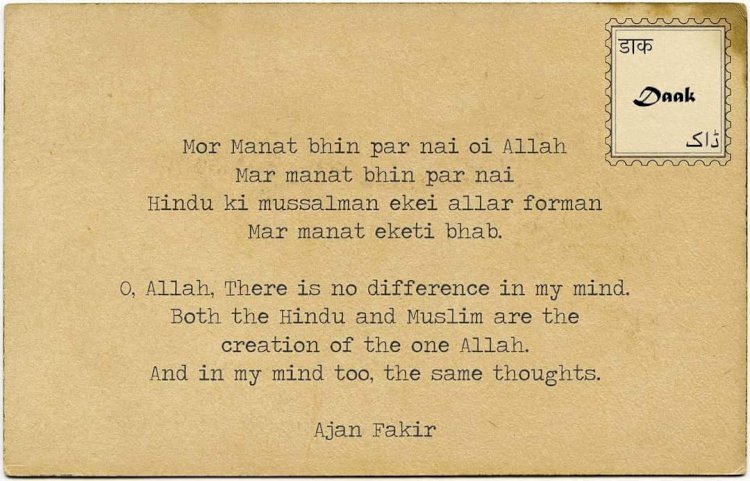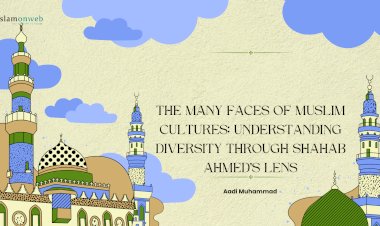Azan Fakir and Mystical Soft-Power of Sufism in the North-eastern Indian State of Assam
Indian tradition and Islamic convention are both deeply based on peace and harmony. They have effectively established the soundly bond of intercultural adoption through soft self and social traction like Sufi and Bhakti Movements. North-East India is a landmark hotspot for integrating these two different cultures. For instance, the Phirni after Zikr-Jari started by Azan Fakir and Prasad after Kirtans include a huge samaj bhojan or social feeding. Historically, Medieval North Eastern India was not thoroughly tranquil as different fight-for-power factors were in a back-to-back confronting mood. Consequently, inter-faith fissures followed by communal disturbance used to occur and the society needed to comply with the lost teachings of syncretism, which was moulded smoothly by the Sufism and Bhakti movements.
The Islamic fabric of Sufism, mixing with contemporary customs, has contributed to building a stronger cohesion of societal anthropology. This amicable tradition is boldly established in the historical track of the currently turmoil-torn atmosphere of North Eastern states, especially in Assam. These regions now suffer from the fire of ultra-nationalism or sometimes hatred of alienation and minority discrimination. In the past, it was a realm of inter-religious and cultural emergence. How did it happen? Through means of language, literature, arts, music and lifestyles; Sufis and Sadhus have made it possible. Zikr and Jari in Assam, Baul Songs in Bengal and lots of other vernacular gravities left this influence.
However, when figures from the mystical forces of Sufism, and Bhakti Movement promulgated by Srimanta Sankardev in the region, took its harmonious approaches of spirituality and real tenets, all people irrespective of status and religion flocked together to their threshold even after their demise. It’s vividly depicted when the Ahom King built the shrine of Azan Fakir Shah Miran at Soragori Sapori in Sibsagar – the state’s cultural capital. In contrast, currently, the region faces religious desecration trends. Still, such factors remain to be explored as a remedy for ongoing disruptions in the region.
Mystical Soft-Power of Sufism
With the advent of Islam, Sufism emerged as a resisting force against worldliness and materialism seeking union with the remembrance of the Almighty God. Unparalleled to the contemporary society of hectic life, greed and enmity, Sufis wielded the inner qualities of love, forgiveness, equality, inter-faith understanding and communal harmony for an ecstatic existence. Sufis are great promoters of secular society in India with cultural and religious assimilation.
During the 16th and 17th centuries, the beauty of Indian tradition was at stake under the shackles of communal hatred, social cacophony, bound of ignorance, and clash of powers. Hazrat Shah Miran, popularly known as Azan Fakir – the steering face of North-East Indian Muslims and pioneer of religious harmony – was hailed as a renaissance man and effectively uniting factor between them all.
Cross-Cultural Bridge
As a dervish in the early 17th century, Shah Miran travelled from Baghdad and settled in the valley of Brahmaputra, Assam. He was a Persian-born Muslim Sufi, a traveller, singer, poet, social reformer and performer of Azan - the call for prayer. At that period, the region was independently ruled by Ahom Hindu kings. Mughals had unsuccessfully led several expeditions to gain control over the kingdom. Apparently, the bilateral diplomacy with this area of Sibsagar was not of a smooth level. Azan Fakir softly influenced local inhabitants and unified them under one umbrella of humanity practising their own rituals.
He stayed in Assam, made it his homeland, and didn't return to his birthplace or anywhere else. He embraced all people of the locality at first and conceived them as his own kith and kin. Getting off Persian, he spoke their language, ate their food, sang their music and taught them the ethos of mingling and multiculturalism – not in theological terminology but, in pragmatic essence also. That’s why the epoch and land turned into a kingdom of peace making a unique culture of Brahmaputra.
Sufism deftly assimilated the Islamic tenets with different vernacular traditions and cultures. This helped local people to know Islam closely and accept it. Thus, Islam influenced the Bhakti movement in the Indian subcontinent and made a rampant reach to all sorts of people from all social strata especially the denied and enslaved ones. For instance, Bulleh Shah, Nizamuddin Auliya and Amir Khusrau are some of many specimens of Sufism. Their impacts on cultural syncretism are a connecting bridge and manifestation of peace.
It is traditionally narrated that two eyes of Azan Fakir were plucked out in a plot of allegedly being a Mughal spy. When the reality became clear that he was a servant of humanity, the administration revered him so much. Later the king ordered the building of a shrine above his grave to allow people to visit him altogether. His stellar service for communal harmony brought two different powers and people of different ethnicities came closer.
Integration and Syncretism – a Literary and Cultural Movement
Commonly, Sufis tend against the rampant conventional practices of orthodoxy even in religion and culture. Not to mention that they exercise the real essence of Truth indeed. Sufi saints transferred the true sense of Islam to the local people. They yielded to locally acquainted instruments to keep sincerity and purity of faith transparent like vernacular music, art and language. In this way, the vernacularisation of Islamic faith is largely centred on the spread of Sufism breaking down the hegemony of Arab-Persian influence and bringing back people to the original track.
The medieval Assam witnessed both forces of syncretism – the Islamic Sufism and the Bhakti Movement of Hinduism. Their gravity made a practical appeal among the masses. Multiculturalism was a great product of their endeavours which put off several atrocities from these regions. Azan Fakir’s contribution to this arena of pluralism inevitably bears a ground-breaking influence.
The great ideal of the Bhakti Movement, Srimanta Sankardev, who came 200 years before Azan Fakir, was an influential Vaishnava saint. The devotional song Borgeet of Vaishnava was widely popular among the public and earned multiple disciples. Azan Fakir precisely related his teachings and songs. Similarly, he composed Islamic devotional songs Zikr and Jari in the vernacular instead of conventional Arabic or Persian. Researchers suggest that his devotional songs, Zikr and Jari, are an indispensable element of Assamese vernacular literature. This attracted mass attention and remained undaunted till the day playing a pivotal role in social bonding.
At the same time, Azan Fakir initiated a new criterion of Phirni feeding after the Zikr assembly sharing love and togetherness. It was already prevalent in the Assam society where present devotees shared Prasad after Kirtans. Social feeding is an effective initiation to spread love among local people. Generally, it was the ultimate aim of Sufis and Sadhus to attain union with the Creator through the service of his creatures. This mystical practice has an unrelenting effect on religious syncretism and cultural assimilation.

Time to Revisit Old Lessons
The gravity of Sufism had pacified the social chaos of Medieval Assam making it a peaceful edifice of inter-religious harmony. Unfortunately, antagonist elements timely emerged in late years splitting this pluralistic fabric of the region. Communal violence was invoked, people felt helpless and displaced, inter-religious harmony was disrupted, and the unity of humanity was lost. In consequence, violence begets violence. To stabilize the disruptive situation in the land of Azan Fakir and Srimanta Sankardev, it’s necessary to retake heed to their teachings. The heart and minds of its people have to be instilled again with the lessons of Sufism and the Bhakti Movement. It is the only solution to share their Phirni or Prasad again with each other. Then, there will be again, sooner or later, the colours of inter-religious unity, multiculturalism and communal harmony.
Conclusion
Indian tradition is adorned with cross-cultural stances. Islamic cult of Sufism has an inerasable sketch in developing religious tolerance, especially in the North-Eastern region of Assam. It has impacted the inter-bonding of different religions and diplomatic politics, literal enrichment and cultural integration. The region had become a safe abode following love, harmony and mutual understanding. Unfortunately, some years were of contrasting incidents where communalism, disagreement and political barbarism arose, inflicting the centuries-old heritage of religious harmony. It’s high time to revisit the moral lessons of those social servants.
Key References
- Zaheer Hussain, Jafri,. Helmut Reifeld, (2006). The Islamic Path: Sufism, Politics, and Society in India, Rainbow Publishers
- Sirajul, (2004) Sufism and Bhakti: A Comparative Study (Cultural Heritage and Contemporary Change. Council for Research in Values
- Sajida Sultana, (2012). Perspectives on Mughal India: Rulers, Historians, 'Ulma' and Sufis: Historiography, Religion and Politics, Sufism and Islamic Renewal, OUP Pakistan
- Prof. Rajendra K. Pandey, Syncretic Traditions and Peaceful Coexistence in India: the Case of Sufism, https://www.globalculturz.org/
• Begum, Tania. (2020) Vernacularization of Islam and Sufism in Medieval Assam: A Study of the Production of Sufi Literature in Local Languages. International Journal of Research and Innovation in Social Science (IJRISS)
About author:
Md Sohel Mondal is from Jharkhand and currently studies in Degree Final Year at Darul Huda Islamic University-NIICS, Kerala.
Disclaimer
The views expressed in this article are the author’s own and do not necessarily mirror Islamonweb’s editorial stance.

























Leave A Comment